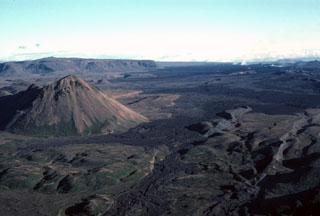Report on Krafla (Iceland) — March 1977
Natural Science Event Bulletin, vol. 2, no. 3 (March 1977)
Managing Editor: David Squires.
Krafla (Iceland) Inflation begins again along with an increase in seismicity
Please cite this report as:
Global Volcanism Program, 1977. Report on Krafla (Iceland) (Squires, D., ed.). Natural Science Event Bulletin, 2:3. Smithsonian Institution. https://doi.org/10.5479/si.GVP.NSEB197703-373080
Krafla
Iceland
65.715°N, 16.728°W; summit elev. 800 m
All times are local (unless otherwise noted)
After the deflation event of 20 January 1977, the Krafla caldera started inflating gain. The rate of uplift near the center was about 10 mm/day. Earthquake activity was at a minimum after the 20 January deflation. During the first week of March the earthquake activity increased again, and during March there have been 100-150 earthquakes per day compared to 100/day prior to the January deflation event, all confined within the caldera. The largest earthquakes are of magnitude 3.6. This increase in seismic activity was predicted two weeks in advance based on the inflation rate of 20 January. One of the fissures monitored during the last few months showed significant widening during the last two inflation periods and contraction during deflation. This fissure is now widening at a slowly increasing rate (Björnsson and others, 1977).
Geological Summary. The Krafla volcanic system in the Northern Volcanic Zone (NVZ) of Iceland is about 100 km long, consisting of a fissure swarm and a central volcano with a 7 x 9 km caldera formed about 110,000 years ago that deposited a rhyolitic welded tuff. It has been moderately active in the Holocene, over three distinct eruptive periods; the current one has lasted about 2,800 years with six volcano-tectonic episodes, each with one or more basaltic fissure eruptions. Lava volumes (DRE) have been in the 0.1-1 km3 range. The Hverfjall and Ludent tuff rings east of Myvatn were erupted along the fissure system. Myvatn lake formed during the eruption of the older Laxarhraun lava flow from the Ketildyngja shield volcano of the Fremrinamur volcanic system about 3,800 years before present (BP); The present Myvatn lake is constrained by the roughly 2,000 years BP younger Laxarhraun lava flow from the Krafla volcanic system. The abundant pseudocraters that form a prominent part of the Myvatn landscape were created when the younger Laxarhraun lava flow entered the lake. The last eruption took place in 1975-1984 CE when nine small basaltic fissure eruptions produced 0.25 km3 of lava.
Information Contacts: K. Grönvald, NVI.

